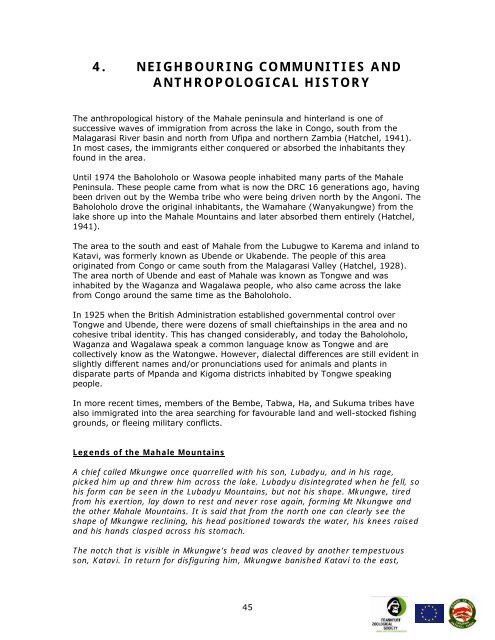Mahale Mountains National Park | Summary of Resource Base
Mahale Mountains National Park | Summary of Resource Base
Mahale Mountains National Park | Summary of Resource Base
You also want an ePaper? Increase the reach of your titles
YUMPU automatically turns print PDFs into web optimized ePapers that Google loves.
4. NEIGHBOURING COMMUNITIES AND<br />
ANTHROPOLOGICAL HISTORY<br />
The anthropological history <strong>of</strong> the <strong>Mahale</strong> peninsula and hinterland is one <strong>of</strong><br />
successive waves <strong>of</strong> immigration from across the lake in Congo, south from the<br />
Malagarasi River basin and north from Ufipa and northern Zambia (Hatchel, 1941).<br />
In most cases, the immigrants either conquered or absorbed the inhabitants they<br />
found in the area.<br />
Until 1974 the Baholoholo or Wasowa people inhabited many parts <strong>of</strong> the <strong>Mahale</strong><br />
Peninsula. These people came from what is now the DRC 16 generations ago, having<br />
been driven out by the Wemba tribe who were being driven north by the Angoni. The<br />
Baholoholo drove the original inhabitants, the Wamahare (Wanyakungwe) from the<br />
lake shore up into the <strong>Mahale</strong> <strong>Mountains</strong> and later absorbed them entirely (Hatchel,<br />
1941).<br />
The area to the south and east <strong>of</strong> <strong>Mahale</strong> from the Lubugwe to Karema and inland to<br />
Katavi, was formerly known as Ubende or Ukabende. The people <strong>of</strong> this area<br />
originated from Congo or came south from the Malagarasi Valley (Hatchel, 1928).<br />
The area north <strong>of</strong> Ubende and east <strong>of</strong> <strong>Mahale</strong> was known as Tongwe and was<br />
inhabited by the Waganza and Wagalawa people, who also came across the lake<br />
from Congo around the same time as the Baholoholo.<br />
In 1925 when the British Administration established governmental control over<br />
Tongwe and Ubende, there were dozens <strong>of</strong> small chieftainships in the area and no<br />
cohesive tribal identity. This has changed considerably, and today the Baholoholo,<br />
Waganza and Wagalawa speak a common language know as Tongwe and are<br />
collectively know as the Watongwe. However, dialectal differences are still evident in<br />
slightly different names and/or pronunciations used for animals and plants in<br />
disparate parts <strong>of</strong> Mpanda and Kigoma districts inhabited by Tongwe speaking<br />
people.<br />
In more recent times, members <strong>of</strong> the Bembe, Tabwa, Ha, and Sukuma tribes have<br />
also immigrated into the area searching for favourable land and well-stocked fishing<br />
grounds, or fleeing military conflicts.<br />
Legends <strong>of</strong> the <strong>Mahale</strong> <strong>Mountains</strong><br />
A chief called Mkungwe once quarrelled with his son, Lubadyu, and in his rage,<br />
picked him up and threw him across the lake. Lubadyu disintegrated when he fell, so<br />
his form can be seen in the Lubadyu <strong>Mountains</strong>, but not his shape. Mkungwe, tired<br />
from his exertion, lay down to rest and never rose again, forming Mt Nkungwe and<br />
the other <strong>Mahale</strong> <strong>Mountains</strong>. It is said that from the north one can clearly see the<br />
shape <strong>of</strong> Mkungwe reclining, his head positioned towards the water, his knees raised<br />
and his hands clasped across his stomach.<br />
The notch that is visible in Mkungwe’s head was cleaved by another tempestuous<br />
son, Katavi. In return for disfiguring him, Mkungwe banished Katavi to the east,<br />
45
















